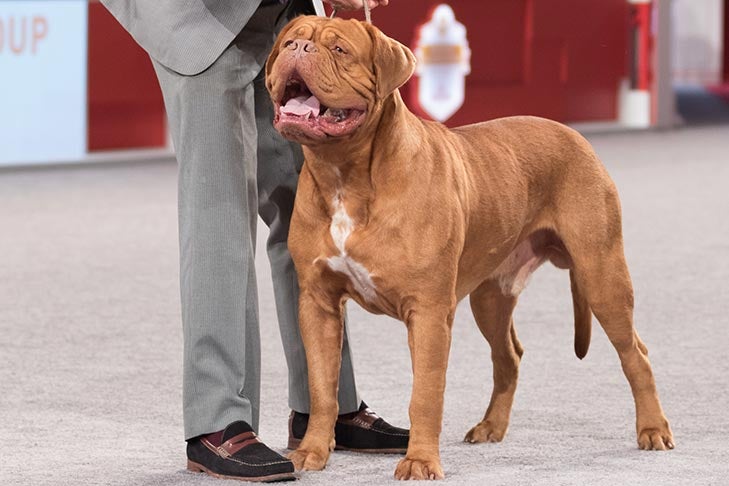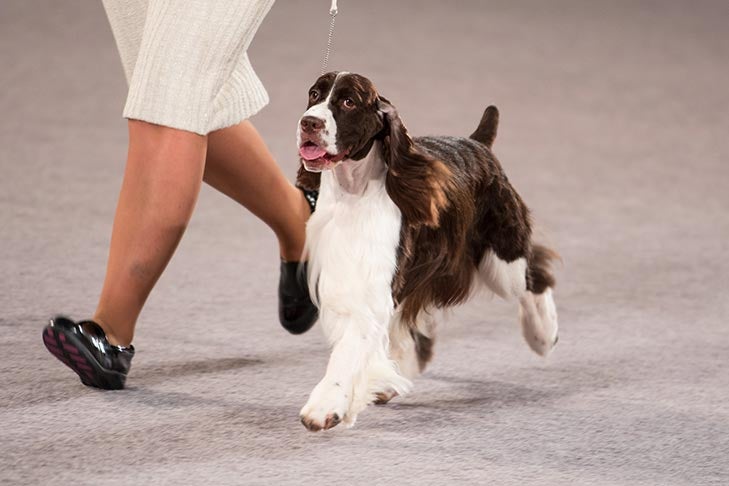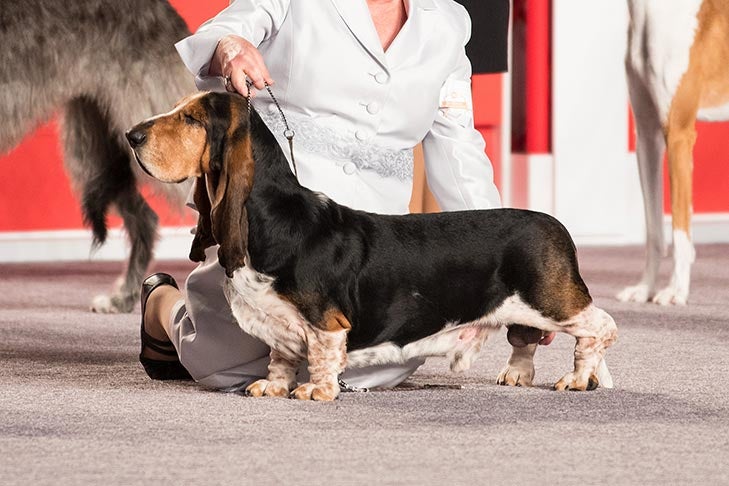Visit an all-breed Conformation show, and hundreds of well-trained dogs groomed to the nines stand politely and run in a pattern. Dog shows are called Conformation—as in, the act of conforming or producing conformity to the breed. Every breed eligible for registration with the American Kennel Club and entered at the show proudly presents their best features.
Conformation events range from all-breed shows to small local specialty club shows, which feature a single breed. Limited-breed events, a Working Group or a Toy Group show, have a group of breeds competing. You’ll seldom hear barks or woofs at conformation shows as the dogs are competing for the title of American Kennel Club Champion, and they take their job seriously.
When you watch a Conformation dog show for the first time, either in person or on television, it can look like fun but somewhat overwhelming. On TV, an announcer introduces the breed but doesn’t explain what’s happening. When attending a dog show, only the Best of Breed dogs judged in the groups at the end of the day are announced. The event is quiet, so it’s hard to keep track of who wins and why.

The Conformation Routine
Dressed in business casual, The handler—either the dog’s owner, breeder, or hired professional, maneuvers the dog on a show lead on the handler’s left side. The objective is to present the dog to one judge, who assesses how the dog conforms to the standard of their particular breed. The closer the dog meets its breed standard, the better the chances of a winning ribbon.
The dog must stand, or “stack,” for the judge’s examination. It’s not a medical exam, but the judge checks the dog’s features to see how closely it meets the breed’s standard. The judge feels various parts of the dog: the angles of the shoulders, hips, and the planes of the head. In heavily coated breeds, the hands-on exam tells the judge more than looking at a standing dog. Breed standards describe how a dog’s head, body, coat, gait, and temperament should look.
For the judge’s exam, small breeds are generally stacked on a table. Other breeds may be stacked on the ground or on a ramp. The judge will then ask the handler to walk or gait their dog around the ring to evaluate the dog’s movement from the front, rear, and side.
To earn the title of Champion of Record and add Ch. in front of its name, a dog must win 15 points at AKC shows. While the maximum number of points awarded at an event is five, each show carries a different point value. The number of points depends on the number of dogs competing in one sex at any show and the AKC Schedule of Points set in each area of the United States. Dogs earn points by defeating other dogs of the same sex and in their breed.

Which Dogs Can Enter
Dogs six months and older who aren’t spayed or neutered, are a recognized AKC breed, and registered with the American Kennel Club are eligible to compete in a Conformation show. Dogs need to be in good health and up-to-date on vaccinations. Kennel clubs also require all dogs to register with the show’s superintendent a few weeks before the show date.
The males are judged separately from the females. Each dog is entered into any one of the various classes which are based conditions such as the dog’s age, the person handling the dog, and if it was whelped in the US. The Novice class is not based on the experience of the person showing the dog. Champions compete in a class of other champions as follows. When registering a dog for a show, owners choose to enter one of these classes:
- Puppy Dogs or Bitches – 6 months and under 9 months.
- Puppy Dogs or Bitches – 9 months and under 12 months.
- Dogs – 12 months and under 18 months.
- Novice
- Amateur-Owner Handled
- Bred by Exhibitor
- American Bred
- Open Dogs
At some shows, the owner may enter a dog or a bitch in the Veterans class seven years and older, which is divided by sex. From these classes, the judge chooses one winner in each sex—a Winners Dog or a Winners Bitch. Clubs may also offer other, “non-regular” classes, such as the Veterans Class. Entries in these classes do not compete for Championship points, but they may still advance to compete for Best of Breed (BOB).

Best of Breed classes include all dogs entered in that class, including both Championship (CH) dogs of record and dogs who the owner believes has attained their CH, but are, at the time, unconfirmed. Champion (CH) titles are granted to dogs that have acquired 15 points, including 2 majors won under different judges, and at least one point under a third, different judge in Conformation.
Winners Dog, Winners Bitch, and all first-place non-regular class winners are entered in the BOB class. From those entries, one dog is selected as Best of Breed, and advances to compete in the group.
These breed champions go on to compete in their groups: Herding, Hound, Non-Sporting, Sporting, Terrier, Toy, and Working Groups. In Group competition, one dog is selected to compete in Best in Show.
How Do I Get Started in Conformation?
Indeed, your dog is the champion of your heart, but if you think your dog may be worthy of the title of CH in front of its name, take a few steps before entering a show to ensure your success:
- Contact your breeder and tell them you’re interested in showing your dog. Ask your breeder to evaluate your dog’s show potential. Some canine features may have changed since the breeder sold your puppy. Your breeder can give you grooming tips and how to show off your dog’s best attributes.
- Study the breed standard and see how close your dog meets the requirements.
- Some clubs offer a four-to-six-month (Beginner Puppy) competition in a separate ring from the regular class. If your puppy is eligible, consider entering your pup in this class to gain some practice in the ring.
- Become familiar with the ring procedure. Go to a show without your dog and watch dog shows on television or online. This preparation will tell you how much training your dog needs and if you can do the job or want to hire a professional handler.

- Take your dog to several Conformation handling classes for training and experience. Your local AKC kennel club or trainer will offer them. In training class, your dog will learn to feel comfortable around other dogs and people and build confidence in the show ring. Basic behavior, such as walking on a leash on the handler’s left side without pulling, how to remain still for the judge’s exam, and how to walk or gait around the ring without galloping.
- Learn how to groom your dog for the best show presentation. Bathe your dog, trim its nails, and brush or comb out any coat tangles. If your breed’s coat requires clipping or scissoring, you’ll also need to learn the best methods for that.
- Review the AKC Rules Applying to Dog Shows.
Another bonus of competing with your dog in a Conformation show is enjoying the camaraderie of other breed owners and enjoying a day out with your canine companion. You may not win at your first show, but you’ll long remember the journey to a championship title.

